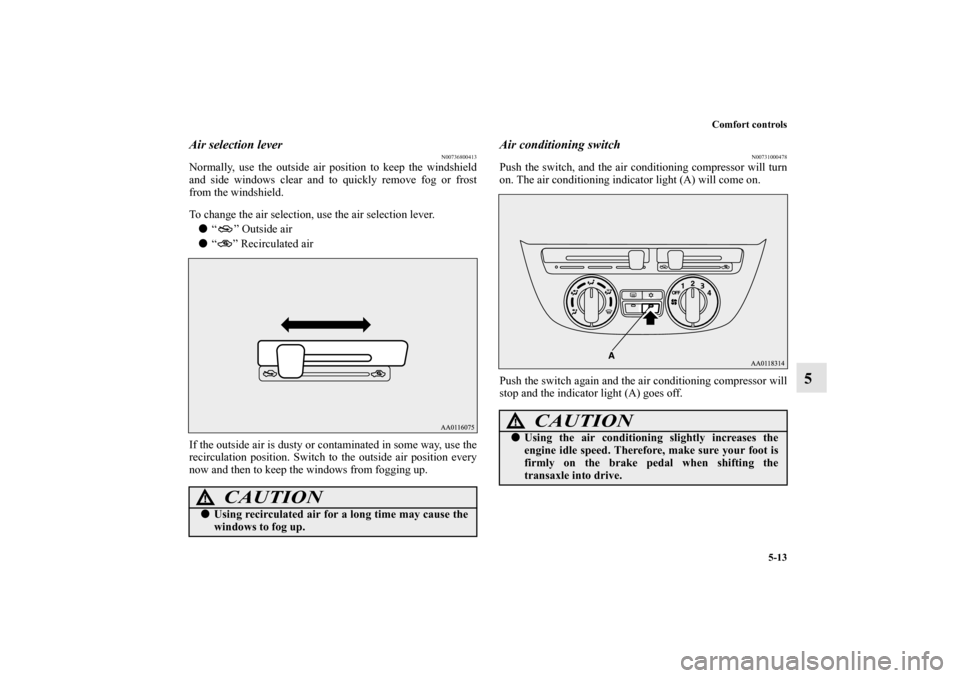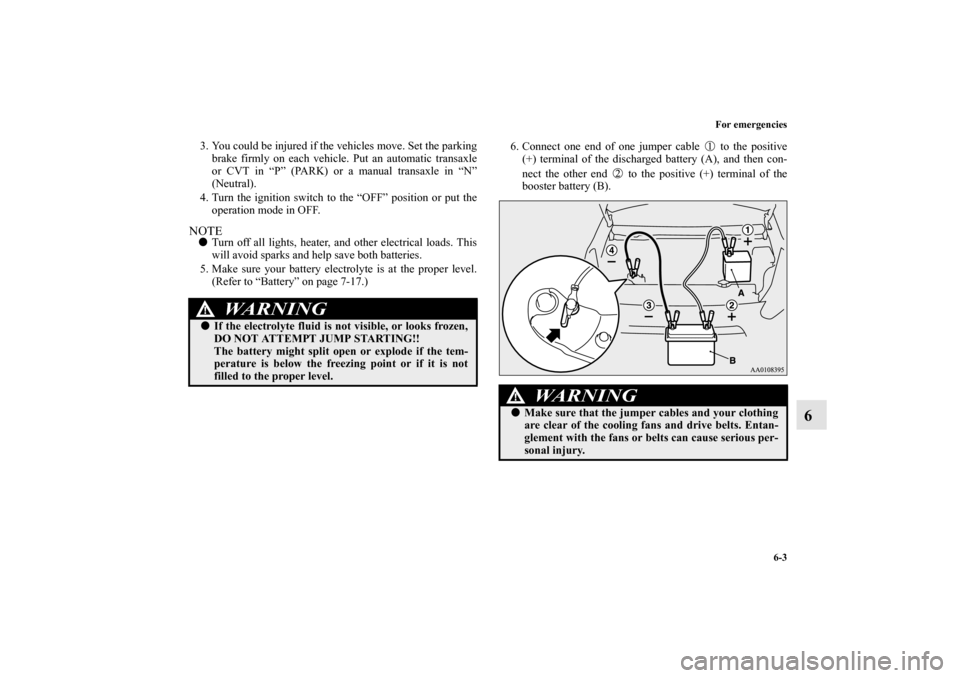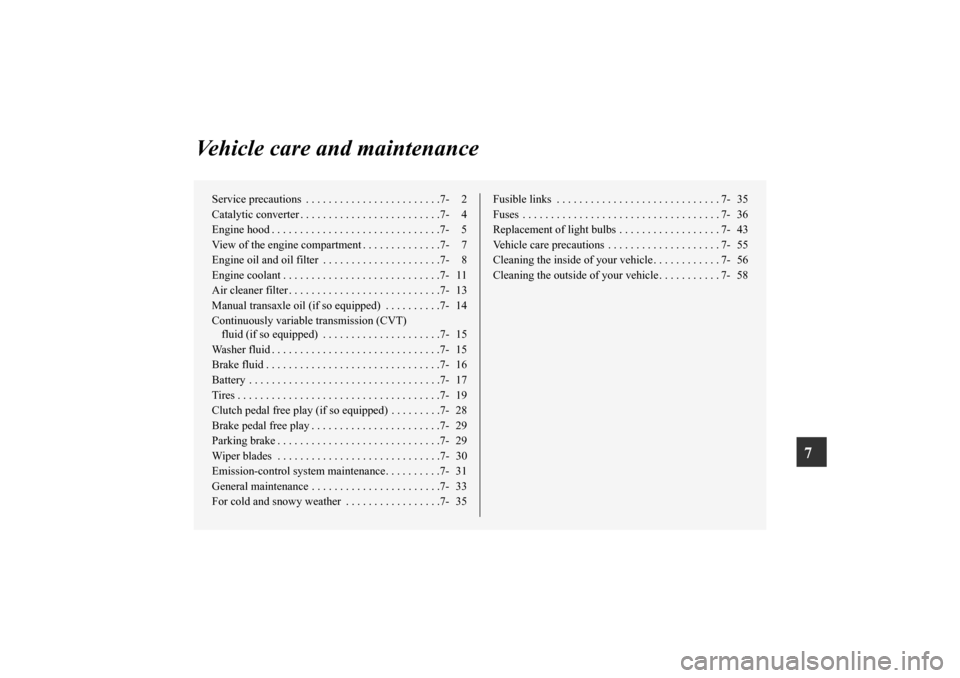Page 285 of 460

Comfort controls
5-13
5
Air selection lever
N00736800413
Normally, use the outside air position to keep the windshield
and side windows clear and to quickly remove fog or frost
from the windshield.
To change the air selection, use the air selection lever.
�“ ” Outside air
�“ ” Recirculated air
If the outside air is dusty or contaminated in some way, use the
recirculation position. Switch to the outside air position every
now and then to keep the windows from fogging up.
Air conditioning switch
N00731000478
Push the switch, and the air conditioning compressor will turn
on. The air conditioning indicator light (A) will come on.
Push the switch again and the air conditioning compressor will
stop and the indicator light (A) goes off.
CAUTION
!�Using recirculated air for a long time may cause the
windows to fog up.
CAUTION
!�Using the air conditioning slightly increases the
engine idle speed. Therefore, make sure your foot is
firmly on the brake pedal when shifting the
transaxle into drive.
BK0162600US.book 13 ページ 2013年3月22日 金曜日 午後2時41分
Page 295 of 460
Comfort controls
5-23
5
NOTE�The factory setting is “Enable automatic air control”.
�When the defogger switch is pressed, the air selection will
automatically change to the outside air position, even if
the system is set to “Disable automatic air control”, in
order to prevent windows from fogging up.
Air conditioning switch
N00737300343
Push the switch, and the air conditioning compressor will turn
on. The “ ” indicator will be shown in the display (A).
Push the switch again and the air conditioning compressor will
stop and the indicator goes off.
CAUTION
!�Using the air conditioning slightly increases the
engine idle speed. Therefore, make sure your foot is
firmly on the brake pedal when shifting the
transaxle into drive.
BK0162600US.book 23 ページ 2013年3月22日 金曜日 午後2時41分
Page 342 of 460

6-2 For emergencies
6If the vehicle breaks down
N00836300233
If your vehicle breaks down on the road, move to the shoulder
and turn on the hazard warning flashers. If there is no shoulder,
or the shoulder is not safe, drive in the right lane slowly with
the hazard lights flashing until you come to a safe stopping
place. Keep the flashers flashing.If the engine stops/failsIf the engine stops, there will be no power assist to the steering
and brakes, making these difficult to use.
�The brake booster will not work, so the brakes will not
grip well. The brake pedal will be harder to press than
usual.
�Since there is no power steering assist, the steering wheel
will be hard to turn.When the engine fails at the intersectionGet help from your passengers, bystanders, etc. to push the
vehicle and move it to a safe area.
Jump-starting the engine
N00836400768
If the engine cannot be started because the battery is weak or
dead, you can start it with the battery from another vehicle
using jumper cables.NOTE�Do not use jumper cables if they have damage or corro-
sion.
1. Take off any metal jewelry such as watch bands or brace-
lets that might create an accidental electrical contact.
2. Position the vehicles close enough together so that the
jumper cables can reach, but be sure the vehicles aren’t
touching each other.
WA R N I N G
!�To reduce the risk of igniting flammable gas that
may be emitted from the battery, carefully read this
section before jump-starting the vehicle.�Do not try to start your vehicle by pushing or tow-
ing. This can cause an accident resulting in serious
injury or death and can damage the vehicle.
CAUTION
!�Check the other vehicle. It must have a 12-volt bat-
tery. If the other system isn’t 12-volt, both systems
can be damaged.
BK0162600US.book 2 ページ 2013年3月22日 金曜日 午後2時41分
Page 343 of 460

For emergencies
6-3
6
3. You could be injured if the vehicles move. Set the parking
brake firmly on each vehicle. Put an automatic transaxle
or CVT in “P” (PARK) or a manual transaxle in “N”
(Neutral).
4. Turn the ignition switch to the “OFF” position or put the
operation mode in OFF.NOTE�Turn off all lights, heater, and other electrical loads. This
will avoid sparks and help save both batteries.
5. Make sure your battery electrolyte is at the proper level.
(Refer to “Battery” on page 7-17.)6. Connect one end of one jumper cable to the positive
(+) terminal of the discharged battery (A), and then con-
nect the other end to the positive (+) terminal of the
booster battery (B).
WA R N I N G
!�If the electrolyte fluid is not visible, or looks frozen,
DO NOT ATTEMPT JUMP STARTING!!
The battery might split open or explode if the tem-
perature is below the freezing point or if it is not
filled to the proper level.
WA R N I N G
!�Make sure that the jumper cables and your clothing
are clear of the cooling fans and drive belts. Entan-
glement with the fans or belts can cause serious per-
sonal injury.
BK0162600US.book 3 ページ 2013年3月22日 金曜日 午後2時41分
Page 345 of 460

For emergencies
6-5
6
As your vehicle has anti-lock brakesIf you drive your vehicle with a low battery charge after the
engine has been started by using jumper cables, the engine may
misfire. This can cause the anti-lock braking system warning
light to blink on and off. This is only due to the low battery
voltage. It is not a problem with the brake system. If this hap-
pens, fully charge the battery and ensure the charging system is
operating properly.
Engine overheating
N00836500365
If the high coolant temperature warning light illuminates dur-
ing the engine is running, the engine may be overheating. If
this happens:
1. Stop the vehicle in a safe place. Turn on the hazard warn-
ing flashers.
2. With the engine still running, carefully raise the engine
hood to vent the engine compartment.
3. Check that the cooling fan is running. If the fan is not
turning, stop the engine immediately and contact an
authorized Mitsubishi Motors dealer or a repair facility of
your choice for assistance.
4. If you see steam or spray coming from under the hood,
turn off the engine.
WA R N I N G
!�To avoid personal injury, keep hands, hair, jewelry
and clothes away from the cooling fan. The cooling
fan can start at any time.
BK0162600US.book 5 ページ 2013年3月22日 金曜日 午後2時41分
Page 358 of 460

6-18 For emergencies
6How to change a tire (Vehicles equipped
with spare tire)
N00836900819
Before changing a tire, first stop your vehicle in a safe, flat
location.
1. Park the vehicle on level and stable ground.
2. Set the parking brake firmly.
3. On vehicles equipped with manual transaxle, stop the
engine and move the gearshift lever to the “R” (Reverse)
position.
On vehicles equipped with continuously variable trans-
mission (CVT), move the selector lever to the “P”
(PARK) position, and stop the engine.
4. Turn on the hazard flashers and set up a warning triangle,
flashing signal light, etc., at an adequate distance from the
vehicle, and have all your passengers exit the vehicle.5. To prevent the vehicle from rolling when it is raised on the
jack, place chocks or blocks (A) at the tire that is diago-
nally opposite from the tire (B) you are changing.
WA R N I N G
!�The jack should not be used for any purpose other
than to change a tire.�Never get under the vehicle or put any portion of
your body under the vehicle while it is supported by
the jack.
BK0162600US.book 18 ページ 2013年3月22日 金曜日 午後2時41分
Page 372 of 460

6-32 For emergencies
6Operation under adverse driving conditions
N00837200750
If your vehicle becomes stuck in sand, mud or
snowIf your vehicle becomes stuck in snow, sand, or mud, it can
often be moved by a rocking motion. Rock your vehicle back
and forth to free it.
Do not rev the engine or spin the wheels. Constant efforts to
free a stuck vehicle can cause overheating and transaxle fail-
ure. Let the engine idle for a few minutes to cool the transaxle
before trying again.
If your vehicle is still stuck after several rocking attempts, call
for a commercial tow truck service.
On wet roads
WA R N I N G
!�When trying to rock your vehicle out of a stuck posi-
tion, make sure that there are no people nearby. The
rocking motion can make your vehicle suddenly
lurch forward or backward, and injure any
bystanders.
CAUTION
!�Avoid flooded roads. Water is often deeper than it
looks, and you could be seriously hurt by driving
into flood water.�When driving in rain, on water-covered roads, or
through a car wash, water could get into the brake
discs and make them fail temporarily. In such cases,
lightly press the brake pedal to see if they are work-
ing properly. If they are not, press the pedal lightly
several times while driving to dry the brake pads or
linings, then check them again.�When driving in rain, a layer of water may form
between the tires and the road surface (hydroplan-
ing). This loosens your tires’ grip on the road, mak-
ing it difficult to steer or brake properly. When
driving on a wet road:
• Drive your vehicle at a safe speed.
• Do not drive on worn tires.
• Always keep the tires at the correct inflation pres-
sures.
BK0162600US.book 32 ページ 2013年3月22日 金曜日 午後2時41分
Page 375 of 460

7
Vehicle care and maintenance
Service precautions . . . . . . . . . . . . . . . . . . . . . . . .7- 2
Catalytic converter . . . . . . . . . . . . . . . . . . . . . . . . .7- 4
Engine hood . . . . . . . . . . . . . . . . . . . . . . . . . . . . . .7- 5
View of the engine compartment . . . . . . . . . . . . . .7- 7
Engine oil and oil filter . . . . . . . . . . . . . . . . . . . . .7- 8
Engine coolant . . . . . . . . . . . . . . . . . . . . . . . . . . . .7- 11
Air cleaner filter . . . . . . . . . . . . . . . . . . . . . . . . . . .7- 13
Manual transaxle oil (if so equipped) . . . . . . . . . .7- 14
Continuously variable transmission (CVT)
fluid (if so equipped) . . . . . . . . . . . . . . . . . . . . .7- 15
Washer fluid . . . . . . . . . . . . . . . . . . . . . . . . . . . . . .7- 15
Brake fluid . . . . . . . . . . . . . . . . . . . . . . . . . . . . . . .7- 16
Battery . . . . . . . . . . . . . . . . . . . . . . . . . . . . . . . . . .7- 17
Tires . . . . . . . . . . . . . . . . . . . . . . . . . . . . . . . . . . . .7- 19
Clutch pedal free play (if so equipped) . . . . . . . . .7- 28
Brake pedal free play . . . . . . . . . . . . . . . . . . . . . . .7- 29
Parking brake . . . . . . . . . . . . . . . . . . . . . . . . . . . . .7- 29
Wiper blades . . . . . . . . . . . . . . . . . . . . . . . . . . . . .7- 30
Emission-control system maintenance. . . . . . . . . .7- 31
General maintenance . . . . . . . . . . . . . . . . . . . . . . .7- 33
For cold and snowy weather . . . . . . . . . . . . . . . . .7- 35Fusible links . . . . . . . . . . . . . . . . . . . . . . . . . . . . . 7- 35
Fuses . . . . . . . . . . . . . . . . . . . . . . . . . . . . . . . . . . . 7- 36
Replacement of light bulbs . . . . . . . . . . . . . . . . . . 7- 43
Vehicle care precautions . . . . . . . . . . . . . . . . . . . . 7- 55
Cleaning the inside of your vehicle . . . . . . . . . . . . 7- 56
Cleaning the outside of your vehicle . . . . . . . . . . . 7- 58
BK0162600US.book 1 ページ 2013年3月22日 金曜日 午後2時41分